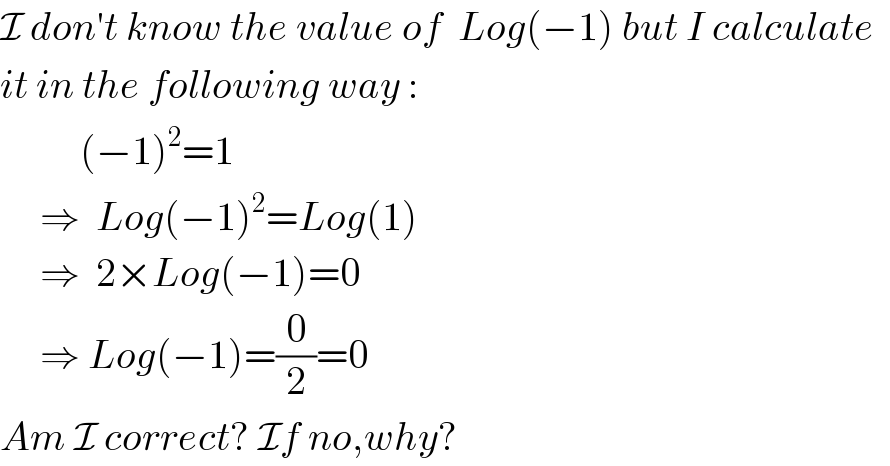
Question Number 3239 by Rasheed Soomro last updated on 08/Dec/15

$$\mathcal{I}\:{don}'{t}\:{know}\:{the}\:{value}\:{of}\:\:{Log}\left(−\mathrm{1}\right)\:{but}\:{I}\:{calculate} \\ $$$${it}\:{in}\:{the}\:{following}\:{way}\:: \\ $$$$\:\:\:\:\:\:\:\:\:\:\left(−\mathrm{1}\right)^{\mathrm{2}} =\mathrm{1} \\ $$$$\:\:\:\:\:\Rightarrow\:\:{Log}\left(−\mathrm{1}\right)^{\mathrm{2}} ={Log}\left(\mathrm{1}\right) \\ $$$$\:\:\:\:\:\Rightarrow\:\:\mathrm{2}×{Log}\left(−\mathrm{1}\right)=\mathrm{0} \\ $$$$\:\:\:\:\:\Rightarrow\:{Log}\left(−\mathrm{1}\right)=\frac{\mathrm{0}}{\mathrm{2}}=\mathrm{0} \\ $$$${Am}\:\mathcal{I}\:{correct}?\:\mathcal{I}{f}\:{no},{why}? \\ $$
Commented by prakash jain last updated on 08/Dec/15

$${y}={e}^{{x}} \Rightarrow{x}=\mathrm{ln}\:{y} \\ $$$${e}^{{ix}} =−\mathrm{1}\Rightarrow\mathrm{cos}\:{x}+{i}\mathrm{sin}\:{x}=−\mathrm{1} \\ $$$${x}=\left(\mathrm{2}{n}+\mathrm{1}\right)\pi \\ $$$$\mathrm{ln}\:\left(−\mathrm{1}\right)={i}\left(\mathrm{2}{n}+\mathrm{1}\right)\pi \\ $$
Commented by prakash jain last updated on 08/Dec/15

$${a}^{\mathrm{2}} ={b}^{\mathrm{2}} \nRightarrow{a}={b} \\ $$
Commented by Rasheed Soomro last updated on 08/Dec/15

$$\mathcal{B}{ut}\:{we}\:{have}\:{not}\:{extracted}\:{square}\:{root}\:{of}\:{both}\:{sides}\:. \\ $$
Commented by prakash jain last updated on 08/Dec/15

$${a}={b} \\ $$$$\mathrm{ln}\:\left(\sqrt{\mathrm{a}}\right)^{\mathrm{2}} =\mathrm{ln}\:{b} \\ $$$$\mathrm{2ln}\:\sqrt{{a}}=\mathrm{ln}\:{b} \\ $$$$\mathrm{ln}\:\sqrt{{a}}=\frac{\mathrm{1}}{\mathrm{2}}\mathrm{ln}\:{b}=\mathrm{ln}\:\sqrt{{b}} \\ $$$${a}={b}=\mathrm{1} \\ $$$$\mathrm{LHS}=\sqrt{{a}}=−\mathrm{1} \\ $$$$\mathrm{RHS}=\sqrt{\mathrm{b}}=\mathrm{1} \\ $$
Commented by Rasheed Soomro last updated on 08/Dec/15

$$\mathcal{O}{k}\:\mathcal{S}{ir}! \\ $$
Commented by prakash jain last updated on 09/Dec/15

$$\mathrm{ln1}=\mathrm{2}{n}\pi{i} \\ $$$$\mathrm{ln}\left(−\mathrm{1}\right)=\left(\mathrm{2}{m}+\mathrm{1}\right){i}\pi \\ $$$$\mathrm{2ln}\left(−\mathrm{1}\right)=\mathrm{2}\left(\mathrm{2m}+\mathrm{1}\right){i}\pi=\mathrm{2}{n}\pi \\ $$$$\mathrm{This}\:\mathrm{is}\:\mathrm{correct}\:\mathrm{result}. \\ $$
Commented by 123456 last updated on 08/Dec/15

$${e}^{\mathrm{2}\pi\imath} ={e}^{\mathrm{0}} \:\mathrm{but}\:\mathrm{2}\pi\imath\neq\mathrm{0} \\ $$
Commented by 123456 last updated on 08/Dec/15

$${e}^{{x}} ={e}^{{y}} \Leftrightarrow{x}={y}\:\mathrm{work}\:\mathrm{only}\:\mathrm{for}\:\left({x},{y}\right)\in\mathbb{R}^{\mathrm{2}} \\ $$$$\mathrm{at}\:\mathrm{complex}\:\mathrm{plane}\:{e}^{{z}} \:\mathrm{dont}\:\mathrm{is}\:\mathrm{one}\:\mathrm{to}\:\mathrm{one} \\ $$$$\mathrm{in}\:\mathrm{fact} \\ $$$${e}^{{z}+\mathrm{2}\pi{n}\imath} ={e}^{{z}} \:\:\:\:\:\:{n}\in\mathbb{Z} \\ $$
Commented by Rasheed Soomro last updated on 08/Dec/15

$$\mathbb{T}\boldsymbol{\mathrm{Han}}\mathbb{K}^{\mathbb{S}} \mathbb{S}_{\mathbb{S}!} !^{!} \\ $$
Commented by 123456 last updated on 09/Dec/15
![just random comment ln1=2πnı 2ln(−1)=2(πı+mπı)=2π(1+m)ı ln(−1)^2 =2ln(−1) n=1+m lnz=ln∣z∣+ı[arg(z)+2πk]](Q3285.png)
$$\mathrm{just}\:\mathrm{random}\:\mathrm{comment} \\ $$$$\mathrm{ln1}=\mathrm{2}\pi{n}\imath \\ $$$$\mathrm{2ln}\left(−\mathrm{1}\right)=\mathrm{2}\left(\pi\imath+{m}\pi\imath\right)=\mathrm{2}\pi\left(\mathrm{1}+{m}\right)\imath \\ $$$$\mathrm{ln}\left(−\mathrm{1}\right)^{\mathrm{2}} =\mathrm{2ln}\left(−\mathrm{1}\right) \\ $$$${n}=\mathrm{1}+{m} \\ $$$$\mathrm{ln}{z}=\mathrm{ln}\mid{z}\mid+\imath\left[\mathrm{arg}\left({z}\right)+\mathrm{2}\pi{k}\right] \\ $$
